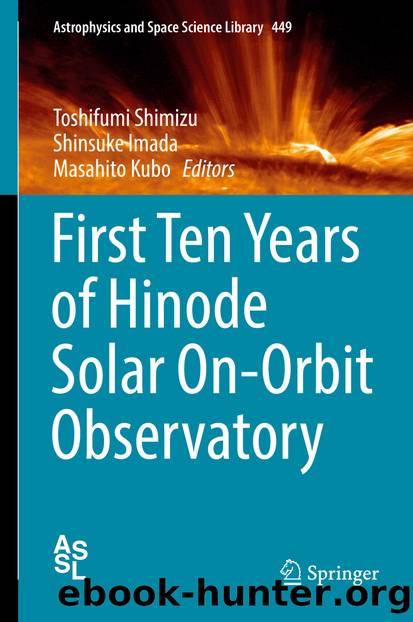First Ten Years of Hinode Solar On-Orbit Observatory by Toshifumi Shimizu Shinsuke Imada & Masahito Kubo

Author:Toshifumi Shimizu, Shinsuke Imada & Masahito Kubo
Language: eng
Format: epub
Publisher: Springer Singapore, Singapore
12.2.2 Consistency with Theoretical Model
We compared the observational findings described in Sect. 12.2.1 to the theoretical flare-trigger model based on the numerical simulations of Kusano et al. (2012, henceforth called âKB12 modelâ ). The basic idea of the model is similar to that of the emerging flux model ; a small-scale bipolar field (blue arcade in the upper schematic of Fig. 12.3) appears on the PIL of the global sheared magnetic field (red arcades in the upper schematic of Fig. 12.3). The shear angle θ 0 of the red magnetic arcades represents the deviation of the global magnetic fields in the AR from the potential field, and it characterizes the magnetic free energy stored in the corona. The azimuthal angle Ï e represents a small-scale magnetic disturbance, which is critical for flare occurrence. KB12 systematically investigated the flux rope formation, occurrence of magnetic reconnection, and physical processes leading to flux rope eruption using ensemble simulations with different combinations of (θ 0, Ï e ). The KB12 model proposed quantitative conditions for flare triggering based on the simulation results, which are summarized in the bottom plot of Fig. 12.3. There are two types of small-scale bipolar fields that can trigger a flare, i.e., the âflare-trigger field â: the âopposite polarity (OP) typeâ and the âreversed shear (RS) type.â In the OP-type case, which is represented by the pink-colored diamonds in Fig. 12.3, the magnetic polarity pattern in the small-scale bipolar field is opposite to that of the global magnetic field, i.e., the azimuth angle Ï e is around 180â. Conversely, the RS-type case, in which the local magnetic shear in the small-scale bipolar field is opposite to the global magnetic shear in the AR (i.e., Ï e is around 270â), is represented by the blue-colored diamonds in Fig. 12.3.
Fig. 12.3Top: Schematic of the simulation setup in KB12. White/black regions represent positive/negative polarities of the magnetic field. The red and blue arrows represent the magnetic field lines in the pre-existing field and the small-scale injected field, which have rotation angles θ 0 and Ï e with respect to the large-sale potential field, respectively. Bottom: Flare phase diagram that summarizes the simulation results. The diamond symbols indicate the regions where the eruption has occurred under the θ 0 and Ï e conditions. The pink and blue diamonds indicate the types of dynamics considered âeruption-induced reconnection (OP-type)â and âreconnection-induced eruption (RS-type),â respectively. The yellow diamond corresponds to a special case where the potential field collapses because of reconnection with the small-scale injected field, which exhibits a completely antiparallel polarity compared with the initial potential field. The open square symbols indicate the regions where eruptions do not occur under the conditions
Download
This site does not store any files on its server. We only index and link to content provided by other sites. Please contact the content providers to delete copyright contents if any and email us, we'll remove relevant links or contents immediately.
| Aeronautics & Astronautics | Astronomy |
| Astrophysics & Space Science | Comets, Meteors & Asteroids |
| Cosmology | Mars |
| Solar System | Star-Gazing |
| Telescopes | UFOs |
Turbulence by E. J. Noyes(7039)
Tools of Titans by Timothy Ferriss(6947)
Astrophysics for People in a Hurry by Neil DeGrasse Tyson(4620)
Room 212 by Kate Stewart(4107)
Pale Blue Dot by Carl Sagan(4001)
The David Icke Guide to the Global Conspiracy (and how to end it) by David Icke(3883)
Secrets of Antigravity Propulsion: Tesla, UFOs, and Classified Aerospace Technology by Ph.D. Paul A. Laviolette(3450)
Apollo 8 by Jeffrey Kluger(3200)
Losing the Nobel Prize by Brian Keating(3187)
A Journey Through Divination and Astronomy by Publishing Pottermore(3071)
Goodbye Paradise(2963)
COSMOS by Carl Sagan(2950)
Brief Answers to the Big Questions by Stephen Hawking(2878)
How to Read Water: Clues and Patterns from Puddles to the Sea (Natural Navigation) by Tristan Gooley(2855)
The Five People You Meet in Heaven by Mitch Albom(2843)
The Order of Time by Carlo Rovelli(2714)
How to Read Nature by Tristan Gooley(2665)
A Brief History of Time by Stephen Hawking(2473)
Aliens by Jim Al-Khalili(2382)
